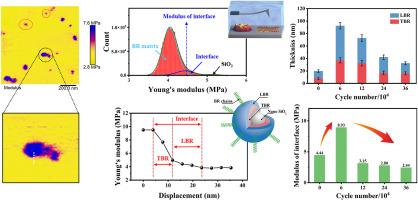介电弹性体纳米复合材料在循环拉伸过程中的非稳态电学性能及其机理
IF 9.8
1区 材料科学
Q1 MATERIALS SCIENCE, COMPOSITES
引用次数: 0
摘要
介电弹性体发生器(DEG)具有重量轻、结构灵活、能量收集能力强等优点,可以为便携式电子设备提供电能。保持DEGs的高性能需要介电弹性体(DE)纳米复合材料在动态拉伸循环中保持优异的电气性能-高绝缘,击穿强度和介电常数。然而,DE复合材料在动态循环拉伸下的非稳态电学性能(NEP),对长期性能至关重要,仍然没有得到充分的研究。本文对纳米二氧化硅/丁二烯橡胶(SiO2/BR)复合材料在循环拉伸下的NEP进行了表征,揭示了一种独特的演化机制:初始循环诱导界面分子链从表面状态重新定向到垂直于SiO2表面的状态,通过将界面厚度和模量增加3.7倍(从4.44 MPa增加到8.93 MPa)来增强绝缘和击穿强度。在60,000次初始循环中,这些变化显著提高了绝缘和击穿强度。然而,随着疲劳的积累,交联网络断裂会增加微损伤和链迁移率,从而扭转这些趋势,降低绝缘和击穿强度。结合红外二色性、原子力显微镜与定量纳米力学制图(AFM-QNM)和宽带介电光谱(BDS),这项工作建立了动态条件下微观结构与NEP之间的相关性,推动了对静态或单参数研究的理解。为制备具有高能量收集性能和长疲劳寿命的DE复合材料提供了指导。本文章由计算机程序翻译,如有差异,请以英文原文为准。

Non-steady-state electrical properties in dielectric elastomer nanocomposites during cyclic stretching and the underlying mechanism
Dielectric elastomer generator (DEG) with the advantages of lightweight, flexible structure and excellent energy harvesting abilities, can supply electrical energy to portable electronic devices. Sustained high performance of DEGs requires dielectric elastomer (DE) nanocomposites to retain superior electrical properties—high insulation, breakdown strength, and dielectric constant—during dynamic stretching cycles. Nevertheless, the non-steady-state electrical properties (NEP) of DE composites under dynamic cyclic stretching, critical for long-term performance, remain insufficiently explored. Here, NEP of nanosilicon dioxide/butadiene rubber (SiO2/BR) composites under cyclic stretching is characterized, revealing a distinct evolution mechanism: initial cycles induce interfacial molecular chains to reorient from a surface-lying state to one perpendicular to SiO2 surfaces, enhancing insulation and breakdown strength via a 3.7-fold increase in interfacial thickness and modulus (from 4.44 MPa to 8.93 MPa). Within 60,000 initial cycles, these changes significantly boost insulation and breakdown strength. However, as fatigue accumulates, crosslink network breakage increases microdamage and chain mobility, reversing these trends and reducing insulation and breakdown strength. Integrating infrared dichroism, atomic force microscopy with quantitative nanomechanical mapping (AFM-QNM), and broadband dielectric spectroscopy (BDS), this work establishes correlations between microstructure and NEP under dynamic conditions, advancing understanding beyond static or single-parameter studies. It provides guidance for fabricating DE composites with high energy harvesting performance and long fatigue life.
求助全文
通过发布文献求助,成功后即可免费获取论文全文。
去求助
来源期刊

Composites Science and Technology
工程技术-材料科学:复合
CiteScore
16.20
自引率
9.90%
发文量
611
审稿时长
33 days
期刊介绍:
Composites Science and Technology publishes refereed original articles on the fundamental and applied science of engineering composites. The focus of this journal is on polymeric matrix composites with reinforcements/fillers ranging from nano- to macro-scale. CSTE encourages manuscripts reporting unique, innovative contributions to the physics, chemistry, materials science and applied mechanics aspects of advanced composites.
Besides traditional fiber reinforced composites, novel composites with significant potential for engineering applications are encouraged.
 求助内容:
求助内容: 应助结果提醒方式:
应助结果提醒方式:


